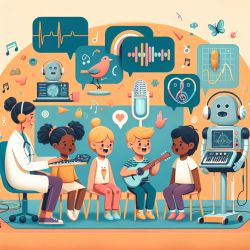The study titled "Language ENvironment Analysis (LENA) with children with hearing loss: A clinical pilot" published in the Canadian Journal of Speech-Language Pathology and Audiology offers insightful data that can significantly enhance clinical practices for children with hearing loss. This blog will explore how practitioners can leverage the findings from this study to improve therapeutic outcomes and encourage further research.
Understanding the LENA System
The LENA system is designed to collect extensive data on a child's language environment through a small, child-worn recording device. It analyzes various variables such as child vocalizations, conversational turn-taking, and adult words spoken to the child. The study aimed to evaluate the feasibility of using the LENA system in a clinical setting and its potential to provide valuable feedback to parents and clinicians.
Key Findings
- Feasibility: Parents found the LENA device easy to use, although children occasionally resisted wearing the specialized clothing.
- Auditory Environment: The data indicated that children spent most of their day in a quiet listening environment, which is conducive to language learning.
- Child Vocalizations and Conversational Turns: The study found that children with hearing loss had vocalization and conversational turn counts within normative ranges when the device was used correctly.
- Adult Word Counts: Most recordings showed adult word counts at the 99th percentile, indicating a rich language environment provided by parents.
Implementing LENA in Clinical Practice
Based on the study's findings, here are some practical steps for clinicians:
- Introduce LENA Gradually: Familiarize the child with the LENA clothing in a comfortable setting, such as during enjoyable play activities.
- Expand Recording Settings: Allow recordings in multiple settings outside the home to capture a more representative sample of the child's daily language environment.
- Provide Feedback: Use the data collected to give parents specific feedback on how to enrich their child's language environment. Visual demonstrations of peak speech times can help parents optimize their interactions.
Encouraging Further Research
The pilot study sets the stage for more extensive research. Future studies could explore the LENA system's application in diverse socio-economic settings and its long-term impact on language development in children with hearing loss. Such research could provide deeper insights and more robust data to inform clinical practices.
To read the original research paper, please follow this link: Language ENvironment Analysis (LENA) with children with hearing loss: A clinical pilot.










